Pilgrimage

A pilgrimage is a journey to a holy place, which can lead to a personal transformation, after which the pilgrim returns to their daily life.[1][2][3]
Background
Pilgrimages frequently involve a journey or search of moral or spiritual significance. Typically, it is a journey to a shrine or other location of importance to a person's beliefs and faith, although sometimes it can be a metaphorical journey into someone's own beliefs.
Many religions attach spiritual importance to particular places: the place of birth or death of founders or saints, or to the place of their "calling" or spiritual awakening, or of their connection (visual or verbal) with the divine, to locations where miracles were performed or witnessed, or locations where a deity is said to live or be "housed", or any site that is seen to have special spiritual powers. Such sites may be commemorated with shrines or temples that devotees are encouraged to visit for their own spiritual benefit: to be healed or have questions answered or to achieve some other spiritual benefit.
A person who makes such a journey is called a pilgrim. As a common human experience, pilgrimage has been proposed as a Jungian archetype by Wallace Clift and Jean Dalby Clift.[4] Some research has shown that people who engage in pilgrimage walks enjoy biological, psychological, social, and spiritual therapeutic benefits.[5]
The Holy Land acts as a focal point for the pilgrimages of the Abrahamic religions of Judaism, Christianity, and Islam. According to a Stockholm University study in 2011, these pilgrims visit the Holy Land to touch and see physical manifestations of their faith, confirm their beliefs in the holy context with collective excitation, and connect personally to the Holy Land.[6]
The Catholic priest Frank Fahey writes that a pilgrim is "always in danger of becoming a tourist" and vice versa, and identifies eight differences between the two:[7]
This article may lend undue weight to certain ideas, incidents, or controversies. (June 2024) |
| Element | Pilgrimage | Tourism |
|---|---|---|
| Faith | always contains "faith expectancy" | not required |
| Penance | search for wholeness | not required |
| Community | often solitary, but should be open to all | often with friends and family, or a chosen interest group |
| Sacred space | silence to create an internal sacred space | not present |
| Ritual | externalizes the change within | not present |
| Votive offering | leaving behind a part of oneself, letting go, in search of a better life | not present; the travel is the good life |
| Celebration | "victory over self", celebrating to remember | drinking to forget |
| Perseverance | commitment; "pilgrimage is never over" | holidays soon end |
Ancient Greece
The Eleusinian mysteries included a pilgrimage. The procession to Eleusis began at the Athenian cemetery Kerameikos and from there the participants walked to Eleusis, along the Sacred Way (Ἱερὰ Ὁδός, Hierá Hodós).[8]
Bahá'í Faith
Bahá'u'lláh decreed pilgrimage to two places in the Kitáb-i-Aqdas: the House of Bahá'u'lláh in Baghdad, Iraq, and the House of the Báb in Shiraz, Iran. Later, ʻAbdu'l-Bahá designated the Shrine of Bahá'u'lláh at Bahji, Israel as a site of pilgrimage.[9] The designated sites for pilgrimage are currently not accessible to the majority of Bahá'ís, as they are in Iraq and Iran respectively, and thus when Bahá'ís currently refer to pilgrimage, it refers to a nine-day pilgrimage which consists of visiting the holy places at the Bahá'í World Centre in northwest Israel in Haifa, Acre, and Bahjí.[9]
Buddhism


In India and Nepal, there are four places of pilgrimage which are tied to the life of Gautama Buddha:
- Lumbini: Buddha's birthplace (in Nepal)
- Bodh Gaya: place of Enlightenment (in the current Mahabodhi Temple, Bihar, India)
- Sarnath: (formally Isipathana, Uttar pradesh, India) where he delivered his first sermon (Dhammacakkappavattana Sutta), and the Buddha taught about the Middle Way, the Four Noble Truths and Noble Eightfold Path
- Kusinara: (now Kusinagar, India) where he attained mahaparinirvana (died)
Other pilgrimage places in India and Nepal connected Gautama Buddha's life are: Savatthi, Pataliputta, Nalanda, Gaya, Vesali, Sankasia, Kapilavastu, Kosambi, Rajagaha.
Other famous places for Buddhist pilgrimage include:
- India: Sanchi, Ellora Caves, Ajanta Caves, also see Buddhist pilgrimage sites in India
- Thailand: Wat Phra Kaew, Wat Pho, Wat Doi Suthep, Phra Pathom Chedi, Sukhothai, Ayutthaya
- Tibet: Lhasa (traditional home of the Dalai Lama), Mount Kailash, Lake Nam-tso
- Cambodia: Wat Botum, Wat Ounalom, Wat Botum, Silver Pagoda, Angkor Wat
- Sri Lanka: Temple of the Tooth, Polonnaruwa, (Kandy), Anuradhapura
- Laos: Pha That Luang, Luang Prabang
- Malaysia: Kek Lok Si, KL Buddhist Maha Vihara
- Myanmar: Shwedagon Pagoda, Mahamuni Buddha Temple, Kyaiktiyo Pagoda, Bagan, Sagaing Hill, Mandalay Hill,
- Nepal: Maya Devi Temple, Boudhanath, Swayambhunath
- Indonesia: Borobudur, Mendut, Sewu
- Taiwan: Fo Guang Shan, Dharma Drum Mountain, Chung Tai Shan, Tzu Chi
- Hong Kong: Po Lin Monastery
- China: Yung-kang, Lung-men caves. The Four Sacred Mountains
- Japan:
- Shikoku Pilgrimage, 88 temple pilgrimage on the island of Shikoku
- Japan 100 Kannon Pilgrimage, pilgrimage composed of the Saigoku, Bandō and Chichibu pilgrimages
- Saigoku Kannon Pilgrimage, pilgrimage in the Kansai region
- Bandō Sanjūsankasho, pilgrimage in the Kantō region
- Chichibu 34 Kannon Sanctuary, pilgrimage in Saitama Prefecture
- Chūgoku 33 Kannon Pilgrimage, pilgrimage in the Chūgoku region
- Kumano Kodō
- Mount Kōya
Christianity


Christian pilgrimage was first made to sites connected with the birth, life, crucifixion and resurrection of Jesus. Aside from the early example of Origen in the third century, surviving descriptions of Christian pilgrimages to the Holy Land date from the 4th century, when pilgrimage was encouraged by church fathers including Saint Jerome, and established by Saint Helena, the mother of Constantine the Great.[10]
The purpose of Christian pilgrimage was summarized by Pope Benedict XVI in this way:
To go on pilgrimage is not simply to visit a place to admire its treasures of nature, art or history. To go on pilgrimage really means to step out of ourselves in order to encounter God where he has revealed himself, where his grace has shone with particular splendour and produced rich fruits of conversion and holiness among those who believe. Above all, Christians go on pilgrimage to the Holy Land, to the places associated with the Lord's passion, death and resurrection. They go to Rome, the city of the martyrdom of Peter and Paul, and also to Compostela, which, associated with the memory of Saint James, has welcomed pilgrims from throughout the world who desire to strengthen their spirit with the Apostle's witness of faith and love.[11]
Pilgrimages were, and are, also made to Rome and other sites associated with the apostles, saints and Christian martyrs, as well as to places where there have been apparitions of the Virgin Mary. A popular pilgrimage journey is along the Way of St. James to the Santiago de Compostela Cathedral, in Galicia, Spain, where the shrine of the apostle James is located. A combined pilgrimage was held every seven years in the three nearby towns of Maastricht, Aachen and Kornelimünster where many important relics could be seen (see: Pilgrimage of the Relics, Maastricht). Chaucer's The Canterbury Tales recounts tales told by Christian pilgrims on their way to Canterbury Cathedral and the shrine of Thomas Becket. Marian pilgrimages remain very popular in Latin America.
Hinduism
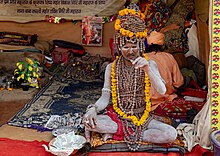
According to Karel Werner's Popular Dictionary of Hinduism, "most Hindu places of pilgrimage are associated with legendary events from the lives of various gods.... Almost any place can become a focus for pilgrimage, but in most cases they are sacred cities, rivers, lakes, and mountains."[12] Hindus are encouraged to undertake pilgrimages during their lifetime, though this practice is not considered absolutely mandatory. Most Hindus visit sites within their region or locale.

- Kumbh Mela: Kumbh Mela is one of the largest gatherings of humans in the world where pilgrims gather to bathe in a sacred or holy river.[13][14][15] The location is rotated among Allahabad, Haridwar, Nashik, and Ujjain.
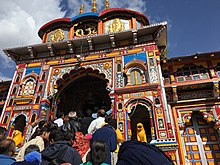
- Char Dham (Four Holy pilgrimage sites): The famous four holy sites Puri, Rameswaram, Dwarka, and Badrinath (or alternatively the Himalayan towns of Badrinath, Kedarnath, Gangotri, and Yamunotri) compose the Char Dham (four abodes) pilgrimage circuit.
- Kanwar Pilgrimage: The Kanwar is India's largest annual religious pilgrimage. As part of this phenomenon, millions of participants gather sacred water from the Ganga (usually in Haridwar, Gangotri, Gaumukh, or Sultanganj) and carry it across hundreds of miles to dispense as offerings in Shiva shrines.[16]
- Old Holy cities per Puranic Texts: Varanasi also known as Kashi (Shiva), Prayagraj, Haridwar-Rishikesh (Vishnu), Mathura-Vrindavan (Krishna), Pandharpur (Krishna), Paithan, Kanchipuram (Parvati), Dwarka (Krishna) and Ayodhya (Rama).
- Major Temple cities: Puri, which hosts a major Vaishnava Jagannath temple and Ratha Yatra celebration; Katra, home to the Vaishno Devi Temple; Three comparatively recent temples of fame and huge pilgrimage are Shirdi, home to Sai Baba of Shirdi, Tirumala - Tirupati, home to the Tirumala Venkateswara Temple; and Sabarimala, where Ayyappan is worshipped.
- Shakti Pithas: Another important set of pilgrimages are the Shakti Pithas, where the Mother Goddess is worshipped, the two principal ones being Kalighat and Kamakhya.
- Pancha Ishwarams - the five ancient Shiva temples of Sri Lanka from classical antiquity.
- The Murugan pilgrimage route of Sri Lanka, an ancient Arunagirinathar-traversed Pada Yatra route of Tiruppadai temples includes the Maviddapuram Kandaswamy Temple in Kankesanturai, the Nallur Kandaswamy temple in Jaffna, the Pancha Ishwaram Koneswaram temple in Trincomalee, the Verugal Murugan Kovil on the banks of the river Verugal Aru, in Verugal, Trincomalee District, the Mandur Kandaswamy temple of Mandur (Sri Lanka), Thirukkovil Sithira Velayutha Swami Kovil, in Thirukkovil, Batticaloa, the Arugam Bay and Panamai in Amparai district, the Ukanthamalai Murugan Kovil, in Okanda, Kumana National Park and then through the park and Tissamaharama to the deity's holiest site, Kataragama temple, Katirkamam in the South.
Islam

The Ḥajj (Arabic: حَـجّ, main pilgrimage to Mecca) is one of the five pillars of Islam and a mandatory religious duty for Muslims that must be carried out at least once in their lifetime by all adult Muslims who are physically and financially capable of undertaking the journey, and can support their family during their absence.[17][18][19] The Hajj is one of the largest annual gatherings of people in the world.[20][21] Since 2014, two or three million people have participated in the Hajj annually.[22] The mosques in Mecca and Medina were closed in February 2020 because of the COVID-19 pandemic and the hajj was permitted for only a very limited number of Saudi nationals and foreigners living in Saudi Arabia starting on 29 July.[23]
Another important place for Muslims is the city of Medina, the second holiest site in Islam, in Saudi Arabia, the final resting place of Muhammad in Al-Masjid an-Nabawi (The Mosque of the Prophet).[24]
The Ihram (white robe of pilgrimage) is meant to show equality of all Muslim pilgrims in the eyes of Allah. 'A white has no superiority over a black, nor a black over a white. Nor does an Arab have superiority over a non-Arab, nor a non-Arab over an Arab - except through piety' - statement of the Prophet Muhammad.
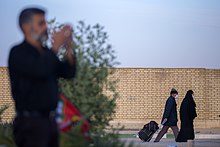
About four million pilgrims participate in the Grand Magal of Touba, 200 kilometres (120 mi) east of Dakar, Senegal. The pilgrimage celebrates the life and teachings of Cheikh Amadou Bamba, who founded the Mouride brotherhood in 1883 and begins on the 18th of Safar.[25]
Shia
Al-Arba‘īn (Arabic: ٱلْأَرْبَـعِـيْـن, "The Forty"), Chehelom (Persian: چهلم, Template:Lang-ur, "the fortieth [day]") or Qirkhī, Imāmīn Qirkhī (Azerbaijani: İmamın qırxı (Arabic: إمامین قیرخی), "the fortieth of Imam") is a Shia Muslim religious observance that occurs forty days after the Day of Ashura. It commemorates the martyrdom of Husayn ibn Ali, the grandson of Muhammad, which falls on the 20th or 21st day of the month of Safar. Imam Husayn ibn Ali and 72 companions were killed by Yazid I's army in the Battle of Karbala in 61 AH (680 CE). Arba'een or forty days is also the usual length of mourning after the death of a family member or loved one in many Muslim traditions. Arba'een is one of the largest pilgrimage gatherings on Earth, in which up to 31 million people go to the city of Karbala in Iraq.[26][27][28][29]
The second largest holy city in the world, Mashhad, Iran, attracts more than 20 million tourists and pilgrims every year, many of whom come to pay homage to Imam Reza (the eighth Shi'ite Imam). It has been a magnet for travelers since medieval times.[30][22]
Judaism
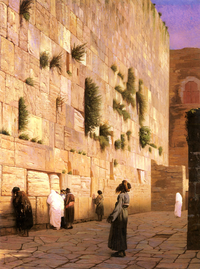
While Solomon's Temple stood, Jerusalem was the centre of the Jewish religious life and the site of the Three Pilgrimage Festivals of Passover, Shavuot and Sukkot, and all adult men who were able were required to visit and offer sacrifices (korbanot) at the Temple. After the destruction of the Temple, the obligation to visit Jerusalem and to make sacrifices no longer applied. The obligation was restored with the rebuilding of the Temple, but following its destruction in 70 CE, the obligation to make a pilgrimage to Jerusalem and offer sacrifices again went into abeyance.[31]
The western retaining wall of the Temple Mount, known as the Western Wall or "Wailing" Wall, is the remaining part of Second Jewish Temple in the Old City of Jerusalem is the most sacred and visited site for Jews. Pilgrimage to this area was off-limits to Jews from 1948 to 1967, when East Jerusalem was under Jordanian control.[32][33]
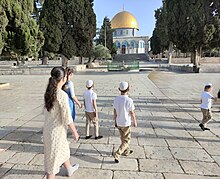
There are numerous lesser Jewish pilgrimage destinations, mainly tombs of tzadikim, throughout Israel and Palestine and all over the world, including: Hebron; Bethlehem; Mount Meron; Netivot; Uman, Ukraine; Silistra, Bulgaria; Damanhur, Egypt; and many others.[34]
Many rabbis claim that even today, after the destruction of the Temple, there is a mitzvah to make a pilgrimage on holidays.[35]
Sikhism

Sikhism does not consider pilgrimage as an act of spiritual merit. Guru Nanak went to places of pilgrimage to reclaim the fallen people, who had turned ritualists. He told them of the need to visit that temple of God, deep in the inner being of themselves. According to him: "He performs a pilgrimage who controls the five vices."[36][37]
Eventually, however, Amritsar and Harmandir Sahib (the Golden Temple) became the spiritual and cultural centre of the Sikh faith, and if a Sikh goes on pilgrimage it is usually to this place.[38]
The Panj Takht (Punjabi: ਪੰਜ ਤਖ਼ਤ) are the five revered gurdwaras in India that are considered the thrones or seats of authority of Sikhism and are traditionally considered a pilgrimage.[39]
Taoism
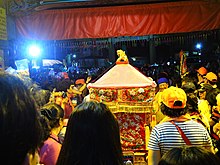
Mazu, also spelled as Matsu, is the most famous sea goddess in the Chinese southeastern sea area, Hong Kong, Macau and Taiwan.
Mazu Pilgrimage is more likely as an event (or temple fair), pilgrims are called as "Xiang Deng Jiao" (pinyin: xiāng dēng jiǎo, it means "lantern feet" in Chinese), they would follow the Goddess's (Mazu) palanquin from her own temple to another Mazu temple. By tradition, when the village Mazu palanquin passes, the residents would offer free water and food to those pilgrims along the way.
There are 2 main Mazu pilgrimages in Taiwan, usually held between lunar January and April, depending on Mazu's will.
- Baishatun Mazu Pilgrimage: this pilgrimage can be traced to 1863, from Baishantun (Miaoli County) to Beigang (Yunlin County) and return, not over a definite route.[40]
- Dajia Mazu Pilgrimage: from Dajia (Taichung City) to Xingang (Chiayi County) and return, it runs over a definite route.[41]
Zoroastrianism

In Iran, there are pilgrimage destinations called pirs in several provinces, although the most familiar ones are in the province of Yazd.[42] In addition to the traditional Yazdi shrines, new sites may be in the process of becoming pilgrimage destinations. The ruins are the ruins of ancient fire temples. One such site is the ruin of the Sassanian era Azargoshnasp fire temple in Iran's Azarbaijan Province. Other sites are the ruins of fire temples at Rey, south of the capital Tehran, and the Firouzabad ruins sixty kilometres south of Shiraz in the province of Pars.
Atash Behram ("Fire of victory") is the highest grade of fire temple in Zoroastrianism. It has 16 different "kinds of fire", that is, fires gathered from 16 different sources.[43] Currently there are 9 Atash Behram, one in Yazd, Iran and the rest in Western India. They have become a pilgrimage destination.[44]
In India the cathedral fire temple that houses the Iranshah Atash Behram, located in the small town of Udvada in the west coast province of Gujarat, is a pilgrimage destination.[44]
Other
Meher Baba
The main pilgrimage sites associated with the spiritual teacher Meher Baba are Meherabad, India, where Baba completed the "major portion"[45] of his work and where his tomb is now located, and Meherazad, India, where Baba resided later in his life.
Yazidism religion
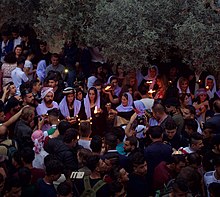
The Yazidism has numerous pilgrimage sites and holy sites, with the most important being located in Sinjar such as Lalish.[46]
See also
- Burial places of founders of world religions
- HCPT – The Pilgrimage Trust
- Hiking
- Journey of self-discovery
- Junrei
- List of shrines
- List of significant religious sites
- Monastery
- New Age travellers
- Pardon (ceremony)
- Religion in pre-Islamic Arabia § Pilgrimages
- Romeria
- Sacred travel
- World Youth Day
- Eastbridge Hospital of St Thomas the Martyr, Canterbury
- Russian wandering
References
- ^ Reader, Ian; Walter, Tony, eds. (2014). Pilgrimage in popular culture. [Place of publication not identified]: Palgrave Macmillan. ISBN 978-1349126392. OCLC 935188979.
- ^ Reframing pilgrimage : cultures in motion. Coleman, Simon, 1963-, Eade, John, 1946-, European Association of Social Anthropologists. London: Routledge. 2004. ISBN 9780203643693. OCLC 56559960.
{{cite book}}: CS1 maint: others (link) - ^ Plate, S. Brent (September 2009). "The Varieties of Contemporary Pilgrimage". CrossCurrents. 59 (3): 260–267. doi:10.1111/j.1939-3881.2009.00078.x. S2CID 170484577.
- ^ Cleft, Jean Darby; Cleft, Wallace (1996). The Archetype of Pilgrimage: Outer Action With Inner Meaning. The Paulist Press. ISBN 0-8091-3599-X.
- ^ Warfield, Heather A.; Baker, Stanley B.; Foxx, Sejal B. Parikh (14 September 2014). "The therapeutic value of pilgrimage: a grounded theory study". Mental Health, Religion & Culture. 17 (8): 860–875. doi:10.1080/13674676.2014.936845. ISSN 1367-4676. S2CID 143623445.
- ^ Metti, Michael Sebastian (1 June 2011). "Jerusalem – the most powerful brand in history" (PDF). Stockholm University School of Business. Archived from the original (PDF) on 26 January 2020. Retrieved 1 July 2011.
- ^ a b Fahey, Frank (April 2002). "Pilgrims or Tourists?". The Furrow. 53 (4): 213–218. JSTOR 27664505.
- ^ Nielsen, Inge (2017). "Collective mysteries and Greek pilgrimage: The cases of Eleusis, Thebes and Andania, in: Excavating Pilgrimage". Excavating Pilgrimage: 28. doi:10.4324/9781315228488-3.
- ^ a b Smith, Peter (2000). "Pilgrimage". A concise encyclopedia of the Bahá'í Faith. Oxford: eworld Publications. pp. 269. ISBN 1-85168-184-1.
- ^ Cain, Andrew (2010). "Jerome's Epitaphium Paulae: Hagiography, Pilgrimage, and the Cult of Saint Paula". Journal of Early Christian Studies. 18: 105–139. doi:10.1353/earl.0.0310. S2CID 170884065.
- ^ "Apostolic Journey to Santiago de Compostela and Barcelona: Visit to the Cathedral of Santiago de Compostela (November 6, 2010) | BENEDICT XVI".
- ^ Werner, Karel (1994). A popular dictionary of Hinduism. Richmond, Surrey: Curzon. ISBN 0700702792. Retrieved 30 October 2016.
- ^ Thangham, Chris V. (3 January 2007). "Photo from Space of the Largest Human Gathering in India". Digital Journal. Retrieved 22 March 2014.
- ^ Banerjee, Biswajeet (15 January 2007). "Millions of Hindus Wash Away Their Sins". The Washington Post. Retrieved 22 March 2014.
- ^ "Millions bathe at Hindu festival". BBC News. 3 January 2007. Retrieved 22 March 2014.
- ^ Singh, Vikas (2017). Uprising of the Fools: Pilgrimage as Moral Protest in Contemporary India. Stanford University Press.
- ^ Long, Matthew (2011). Islamic Beliefs, Practices, and Cultures. Marshall Cavendish Corporation. p. 86. ISBN 978-0-7614-7926-0. Retrieved 2 September 2014.
- ^ Nigosian, S. A. (2004). Islam: Its History, Teaching, and Practices. Indiana: Indiana University Press. p. 110. ISBN 0-253-21627-3.
- ^ "Islamic Practices". Berkley Center for Religion, Peace & World Affairs. Retrieved 7 April 2017.
- ^ Mosher, Lucinda (2005). Praying: The Rituals of Faith. Church Publishing, Inc. p. 155. ISBN 9781596270169. Retrieved 18 September 2014.
- ^ Katz, Andrew (16 October 2013). "As the Hajj Unfolds in Saudi Arabia, A Deep Look Inside the Battle Against MERS". Time. Retrieved 17 October 2013.
- ^ a b "The world's largest Muslim pilgrimage site? Not Mecca, but the Shiite shrine in Karbala". Religion News Service. 9 September 2020. Retrieved 14 September 2020.
- ^ "Hajj Begins in Saudi Arabia Under Historic COVID Imposed Restrictions | Voice of America - English". www.voanews.com. VOA. 29 July 2020. Retrieved 14 September 2020.
- ^ Ariffin, Syed Ahmad Iskandar Syed (2005). Architectural conservation in Islam: case study of the Prophet's Mosque (1st ed.). Skudai, Johor Darul Ta'zim, Malaysia: Penerbit Universiti Teknologi Malaysia. ISBN 9835203733. Retrieved 30 October 2016.
- ^ Holloway, Beetle (21 November 2018). "Senegal's Grand Magal of Touba: A Pilgrimage of Celebration". Culture Trip. Retrieved 14 September 2020.
- ^ uberVU – social comments (5 February 2010). "Friday: 46 Iraqis, 1 Syrian Killed; 169 Iraqis Wounded - Antiwar.com". Original.antiwar.com. Retrieved 30 June 2010.
- ^ Aljazeera. "alJazeera Magazine – 41 Martyrs as More than Million People Mark 'Arbaeen' in Holy Karbala". Aljazeera.com. Retrieved 30 June 2010.
- ^ "Powerful Explosions Kill More Than 40 Shi'ite Pilgrims in Karbala". Voanews.com. 5 February 2010. Retrieved 30 June 2010.
- ^ Hanun, Abdelamir (5 February 2010). "Blast in crowd kills 41 Shiite pilgrims in Iraq". News.smh.com.au. Retrieved 30 June 2010.
- ^ "Sacred Sites: Mashhad, Iran". sacredsites.com. Archived from the original on 27 November 2010. Retrieved 13 March 2006.
- ^ Williams, Margaret, 1947- (2013). Jews in a Graeco-Roman environment. Tübingen, Germany. p. 42. ISBN 978-3-16-151901-7. OCLC 855531272.
{{cite book}}: CS1 maint: location missing publisher (link) CS1 maint: multiple names: authors list (link) CS1 maint: numeric names: authors list (link) - ^ "The Western Wall". mosaic.lk.net. Retrieved 6 June 2017.
- ^ "The Western Wall: History & Overview". www.jewishvirtuallibrary.org. Retrieved 27 March 2018.
- ^ See David M. Gitlitz and Linda Kay Davidson, Pilgrimage and the Jews (Westport, CT: Praeger, 2006) for history and data on several pilgrimages to both Ashkenazi and Sephardic holy sites.
- ^ Rabbi Eliezer Melamed, Making the Pilgrimage Nowadays in Peninei Halakha
- ^ Mansukhani, Gobind Singh (1968). Introduction to Sikhism: 100 Basic Questions and Answers on Sikh Religion and History. India Book House. p. 60.
- ^ Myrvold, Kristina (2012). Sikhs Across Borders: Transnational Practices of European Sikhs. A&C Black. p. 178. ISBN 9781441103581.
- ^ "Sikhism". Archived from the original on 23 November 2001.
- ^ "Special train to connect all five Takhats, first run on February 16". The Times of India. 5 February 2014. Retrieved 5 February 2014.
- ^ "沒固定路線、全憑神轎指引徒步400里...白沙屯媽祖進香有何秘密?他爆出這些「神蹟」超驚奇". The Storm Media (in Chinese (Taiwan)). Central News Agency (published 19 April 2018). 21 May 2018. Retrieved 6 June 2018.
{{cite web}}: CS1 maint: others (link) - ^ "~ 大甲媽祖遶境進香歷史沿革、陣頭、典禮、禁忌的介紹~". 淨 空 禪 林 (in Chinese (Taiwan)). 21 May 2018.
- ^ Aspandyar Sohrab Gotla (2000). "Guide to Zarthoshtrian historical places in Iran." University of Michigan Press. LCCN 2005388611 pg. 164
- ^ Hartman, Sven S. (1980). Parsism: The Religions of Zoroaster. BRILL. p. 20. ISBN 9004062084.
- ^ a b Shelar, Jyoti (1 December 2017). "Pilgrimage or mela? Parsis split on Udvada festival". The Hindu. Retrieved 21 December 2017.
- ^ Deshmukh, Indumati (1961). "Address in Marathi." The Awakener 7 (3): 29.
- ^ The Yazidis: Religion, Society and Resentments. pp. 165–174.
Further reading
- Coleman, Simon. Powers of Pilgrimage: Religion in a World of Movement. United States, NYU Press, 2022.
- al-Naqar, Umar. 1972. The Pilgrimage Tradition in West Africa. Khartoum: Khartoum University Press. [includes a map 'African Pilgrimage Routes to Mecca, ca. 1300–1900']
- Coleman, Simon and John Elsner (1995), Pilgrimage: Past and Present in the World Religions. Cambridge: Harvard University Press.
- Coleman, Simon & John Eade (eds) (2005), Reframing Pilgrimage. Cultures in Motion. London: Routledge.
- Davidson, Linda Kay and David M. Gitlitz (2002), Pilgrimage: From the Ganges to Graceland: An Encyclopedia. Santa Barbara, Ca.: ABC-CLIO.
- Gitlitz, David M. and Linda Kay Davidson (2006). Pilgrimage and the Jews. Westport, CT: Praeger.
- Jackowski, Antoni. 1998. Pielgrzymowanie [Pilgrimage]. Wroclaw: Wydawnictwo Dolnoslaskie.
- Kerschbaum & Gattinger, Via Francigena – DVD – Documentation, of a modern pilgrimage to Rome, ISBN 3-200-00500-9, Verlag EUROVIA, Vienna 2005
- Margry, Peter Jan (ed.) (2008), Shrines and Pilgrimage in the Modern World. New Itineraries into the Sacred. Amsterdam: Amsterdam University Press.
- Okamoto, Ryosuke (2019). Pilgrimages in the Secular Age: From El Camino to Anime. Tokyo: Japan Publishing Industry Foundation for Culture.
- Sumption, Jonathan. 2002. Pilgrimage: An Image of Mediaeval Religion. London: Faber and Faber Ltd.
- Wolfe, Michael (ed.). 1997. One Thousands Roads to Mecca. New York: Grove Press.
- Zarnecki, George (1985), The Monastic World: The Contributions of The Orders. pp. 36–66, in Evans, Joan (ed.). 1985. The Flowering of the Middle Ages. London: Thames and Hudson Ltd.
- Zwissler, Laurel (2011). "Pagan Pilgrimage: New Religious Movements Research on Sacred Travel within Pagan and New Age Communities". Religion Compass. 5 (7). Wiley: 326–342. doi:10.1111/j.1749-8171.2011.00282.x. ISSN 1749-8171.
External links
 Media related to Pilgrimage at Wikimedia Commons
Media related to Pilgrimage at Wikimedia Commons
